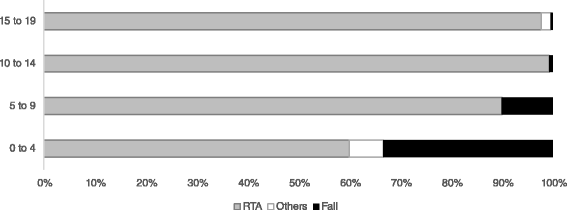The epidemiology of childhood brain injury in the state of Selangor and Federal Territory of Kuala Lumpur, Malaysia
- PMID: 27122016
- PMCID: PMC4847198
- DOI: 10.1186/s12887-016-0590-1
The epidemiology of childhood brain injury in the state of Selangor and Federal Territory of Kuala Lumpur, Malaysia
Abstract
Background: There are limited studies describing the epidemiology of childhood brain injury, especially in developing countries. This study analyses data from the Malaysian National Trauma Database (NTrD) registry to estimate the incidence of childhood brain injury among various demographic groups within the state of Selangor and Federal Territory of Kuala Lumpur.
Methods: This study analysed all traumatic brain injury cases for children ages 0-19 included in the 2010 NTrD report.
Results: A total of 5,836 paediatric patients were admitted to emergency departments (ED) of reporting hospitals for trauma. Of these, 742 patients (12.7 %) suffered from brain injuries. Among those with brain injuries, the mortality rate was 11.9 and 71.2 % were aged between 15 and 19. Traffic accidents were the most common mode of injury (95.4 %). Out of the total for traffic accidents, 80.2 % of brain injuries were incurred in motorcycle accidents. Severity of injury was higher among males and patients who were transferred or referred to the reporting centres from other clinics. Glasgow Coma Scale (GCS) total score and type of admission were found to be statistically significant, χ (2) (5, N = 178) = 66.53, p < 0.001, in predicting patient outcomes. According to this analysis, the overall rate of childhood brain injury for this one year period was 32 per 100,000 children while the incidence of significant (moderate to severe) brain injury was approximately 8 per 100,000 children.
Conclusions: This study provides an overview of traumatic brain injury rates among children within the most populous region of Malaysia. Most brain injuries occurred among older male children, with traffic, specifically motorcycle-related, accidents being the main mode of injury. These findings point to risk factors that could be targeted for future injury prevention programs.
Keywords: Children; Incidence; Road traffic accident; Traumatic brain injury.
Figures
Similar articles
-
Distribution and characteristics of severe traumatic brain injury at Mulago National Referral Hospital in Uganda.World Neurosurg. 2015 Mar;83(3):269-77. doi: 10.1016/j.wneu.2014.12.028. Epub 2014 Dec 19. World Neurosurg. 2015. PMID: 25529531
-
Characteristics and clinical predictors of minor head injury in children presenting to two Malaysian accident and emergency departments.Singapore Med J. 2005 May;46(5):219-23. Singapore Med J. 2005. PMID: 15858690
-
Injury pattern, hospital triage, and mortality of 1250 patients with severe traumatic brain injury caused by road traffic accidents.J Neurotrauma. 2014 Mar 1;31(5):459-65. doi: 10.1089/neu.2013.3111. Epub 2013 Dec 21. J Neurotrauma. 2014. PMID: 24093437
-
Epidemiology of Global Pediatric Traumatic Brain Injury: Qualitative Review.World Neurosurg. 2016 Jul;91:497-509.e1. doi: 10.1016/j.wneu.2016.03.045. Epub 2016 Mar 25. World Neurosurg. 2016. PMID: 27018009 Review.
-
Epidemiologic aspects of brain injury.Neurol Clin. 1996 May;14(2):435-50. doi: 10.1016/s0733-8619(05)70266-8. Neurol Clin. 1996. PMID: 8827181 Review.
Cited by
-
Utility of systemic immune-inflammation index, neutrophil-to-lymphocyte ratio, and platelet-to-lymphocyte ratio as a predictive biomarker in pediatric traumatic brain injury.Surg Neurol Int. 2024 Dec 6;15:456. doi: 10.25259/SNI_900_2024. eCollection 2024. Surg Neurol Int. 2024. PMID: 39777169 Free PMC article.
-
Target-controlled Infusion Propofol Versus Sevoflurane Anaesthesia for Emergency Traumatic Brain Surgery: Comparison of the Outcomes.Malays J Med Sci. 2017 Oct;24(5):73-82. doi: 10.21315/mjms2017.24.5.8. Epub 2017 Oct 26. Malays J Med Sci. 2017. PMID: 29386974 Free PMC article.
References
-
- Zaloshnja E, Miller T, Langlois JA, Selassie AW. Prevalence of long-term disability from traumatic brain injury in the civilian population of the United States, 2005. J Head Trauma Rehabil. 2008;23(6):394–400. doi: 10.1097/01.HTR.0000341435.52004.ac. - DOI - PubMed
-
- Faul M, Xu L, Wald MM, Coronado VG. Traumatic Brain Injury in the United States: Emergency departments visits, hospitalizations and deaths 2002–2006. In Centers for Disease Control and Prevention 2010. http://www.cdc.gov/traumaticbraininjury/pdf/blue_book.pdf. Accessed 24 May 2014.
MeSH terms
LinkOut - more resources
Full Text Sources
Other Literature Sources


